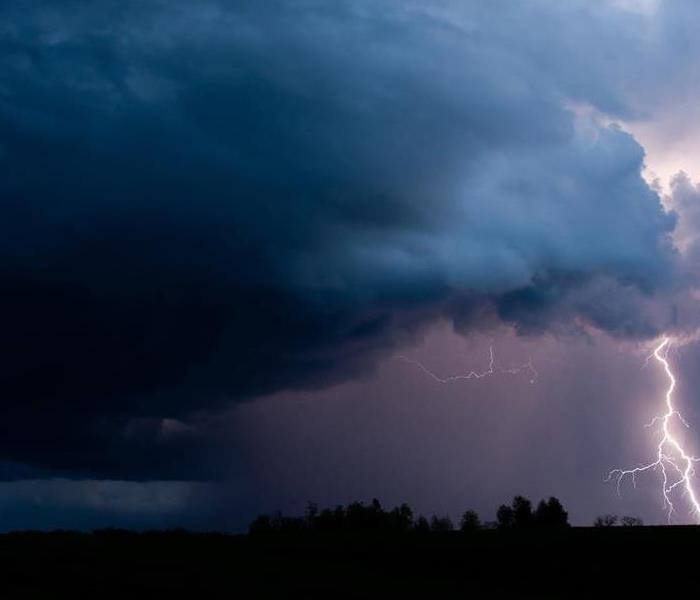Archived Storm Damage Blog Posts
Calm Before the Storm
9/26/2022 (Permalink)
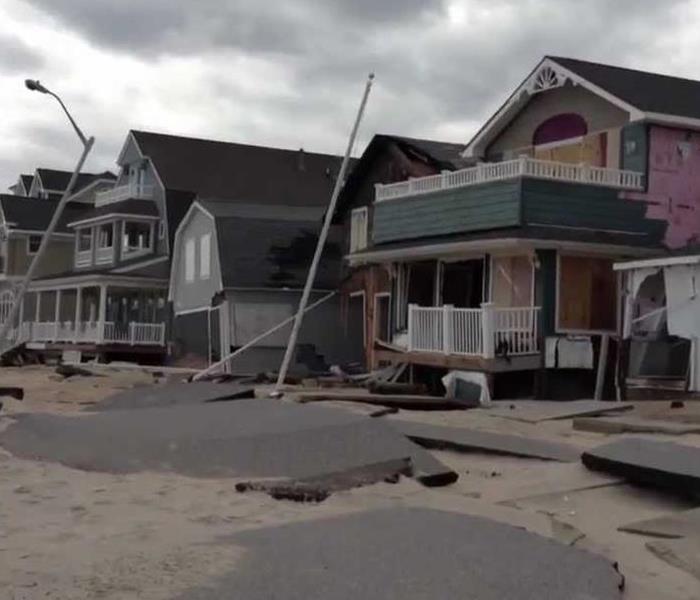 Hurricane Sandy 2012
Hurricane Sandy 2012
Catastrophes happen, and always when we least expect it. When a homeowners worst fears come to life, and the entire area is overcome with grief and needs help, SERVPRO of East Greenville is here to help. Our dedicated team is always ready to go out and help. If a hurricane comes up the coast and local communities are in need of more than the SERVPRO in their counties can handle, our Storm team will be ready to get on the road and help relieve the mitigation teams already on site. Here at SERVPRO of East Greenville, we take pride in helping out community, and we would want help if our home got over taken by a natural disaster, so we are always ready to help when and wherever we are able. Storms happen, and we can never fully prepare for the aftermath. But SERVPRO of East Greenville is ready to help calm the storm.
The 3 Major Storm Damage Types | SERVPRO® of East Greenville County
9/7/2022 (Permalink)
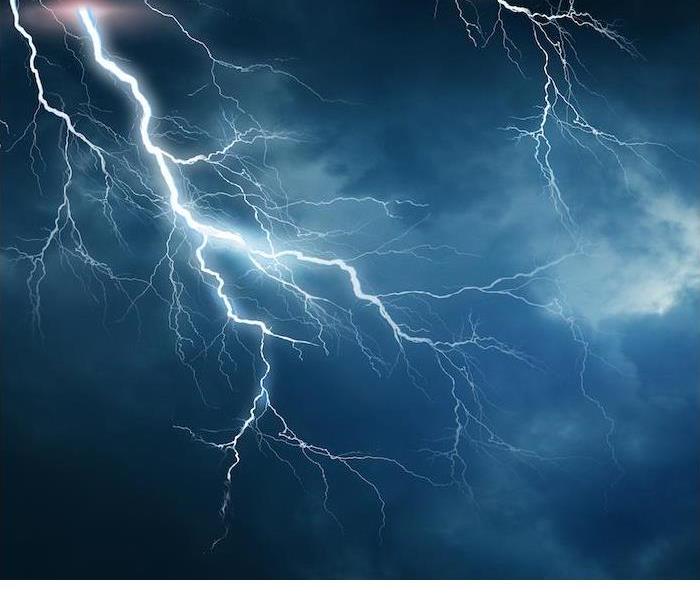 Storms can evolve instantaneously
Storms can evolve instantaneously
Severe storms can be devastating to homeowners. While many homes these days are built to endure weather events of any severity, almost every property and house will experience some degree of destruction when severe storms strike.
Strong wind gusts and wind disasters can throw debris all over the place, as well as cause heavy rains, snowstorms, lightning and floods, depending on the time of year and the storm. All pose a serious risk to your property and your home’s structure.
Depending on the kind of storm and events taking place, your house may be exposed to varying levels of damage. The landscape around your home, the geography of the area and the condition of your home’s foundation or building materials all play a role in determining the extent of possible harm. (We admit that there is an element of chance involved.)
While it’s helpful to be familiar with every type of storm damage, in our area, Greenville is particularly vulnerable to flooding, thunderstorms and hail. Thunderstorms with strong winds are particularly common in our area.
Unless authorities authorize you to do so, you should never stay in your home after it’s been damaged by a storm. Some kinds of damage won’t be noticeable to the naked eye, so it is important to have the building checked out.
Wind
When structures are subjected to powerful gusts of wind at extraordinarily high speeds, this type of destruction follows. Tornadoes and hurricanes are the most prevalent causes of high winds, but even thunderstorms can produce gusts of up to 100 mph.
Extreme wind gusts might scoop up debris in your yard and throw it into your vehicles or home. When a storm approaches, it is critical to remain inside and away from any windows or outside walls in case glass shatters or the walls are damaged by debris.
You can also take action in advance of the storm to reduce the amount of wind-related damage. Clear out any items that the wind may be able to toss around, like limbs, big rocks, loose furniture and dead trees.
Water
Water damage is a very frequent occurrence both during and following a storm. Even a minor storm can produce heavy downpours that cause water to gather outside your home and then make its way inside through the openings on your doors and windows.
If there is enough water present, it may potentially drip into your foundation and severely damage its structural integrity.
Consider using specific landscaping designs that allow water to flow away from your home rather than accumulate next to it to reduce the amount of damage that water may do to your home. You could even install a rain garden, which is a decorative way to enhance your yard and keep all that rainwater from becoming a major issue.
For your downspouts to function as intended and keep the weight of water off your roof, you should also regularly clean them. Water can collect in clogged gutters and find its way into your house from the top, seeping down to the bottom.
Impact
Another common kind of storm damage that can have disastrous effects on your home is “impact damage.” Strong winds can cause trees to topple or debris to be thrown into your property, causing damage. In short, this type of damage is caused by anything that impacts or hits your home or other items on your property.
To avoid the disastrous impact of severe weather, trim any trees that are growing over your home and remove any that are decaying. This can prevent Mother Nature from giving you and your home any trouble when strong winds blow.
Disasters brought on by the weather cost almost $145 billion in losses in the United States alone in 2021. These suggestions could help you save a lot of money and time and improve the security of your home by preventing these calamities before they touch our area.
If your home suffers the effects of severe weather, contact the experts at SERVPRO of East Greenville County. With state-of-the-art equipment and years of experience, our restoration specialists can tackle any tragedy.
When you suffer storm-related damage to your home or business, it’s important that you know who to call! Contact us today to get your storm damage restoration started faster.
Prepare for Storm Season
8/31/2022 (Permalink)
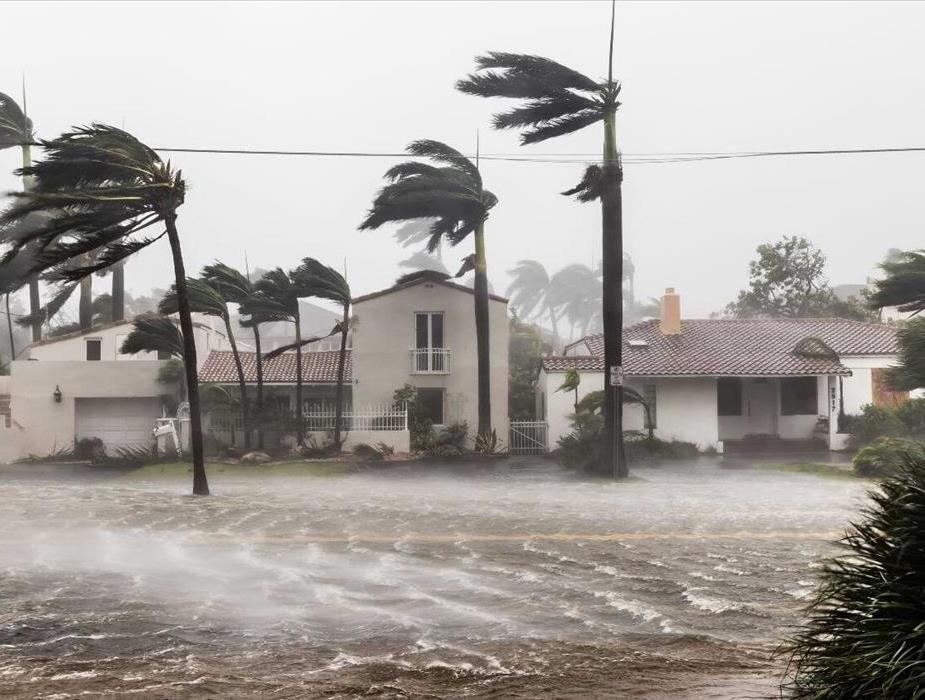 Be prepared now to prevent further damages.
Be prepared now to prevent further damages.
There are several ways to limit the amount of damage a storm can do to your home at every stage. The first two tips assume that a storm is not imminent. The last two tips are for when a severe system is heading your way and has passed over. Taken together, these four storm tips can help you prevent and mitigate storm damage.
1. Trim Trees
The most important damage prevention tip is to trim trees. Precipitation adds extra weight and high winds can tear off heavy branches. Prune overhanging or dead branches on a regular basis.
2. Clear the Drainage System
Downspouts and gutters should collect water from your roof and carry it down and away from the foundation of your home. If the drainage system is blocked, water may collect and work its way under shingles to cause leaks. Water pouring straight down may lead to a flooded basement.
3. Protect Windows With Boards or Shutters
The best storm tip for when a severe storm is on the way is to cover windows with boards or shutters. If you live in a region with frequent storms, invest in storm shutters.
4. Cover Roof Leaks or Broken Windows
If a storm damages your home, take steps toward mitigation while you wait for roofers or restoration experts to arrive. Cover roof leaks with boards or tarps after the storm passes over. Make sure that water will not work its way under the covering. If you did not board up or shutter windows and they get broken, you can use the same materials to keep debris out of your home.
These four storm tips are intended to help you plan ahead for a storm and take measures to mitigate any damage that occurs. If your home in Spartanburg has sustained storm damage, schedule a consultation with a damage restoration service.
Roof Damage on Your Greenville, SC property
10/15/2021 (Permalink)
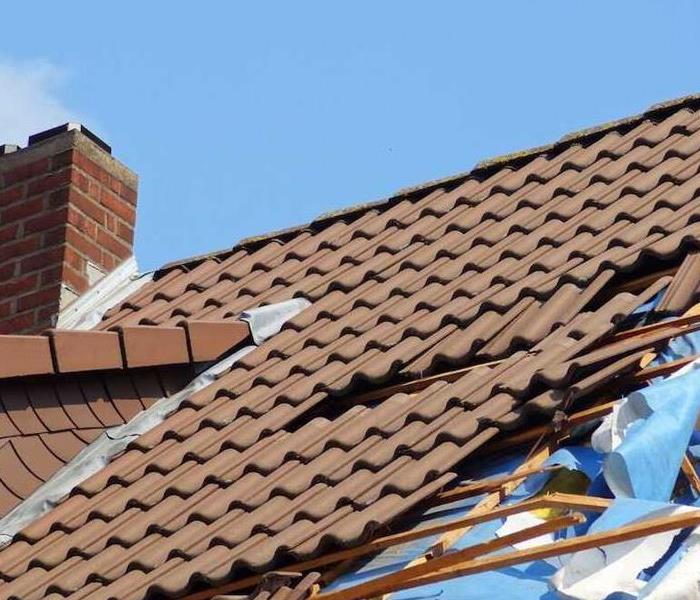 The professionals at SERVPRO of East Greenville County can simplify the restoration process by handling both the initial damage and rebuilding.
The professionals at SERVPRO of East Greenville County can simplify the restoration process by handling both the initial damage and rebuilding.
Has your property in Greenville, SC been damaged by a storm? High winds, hailstones, debris, and other factors may cause severe Storm Damage and Water Damage to some parts of your home. Exterior surfaces such as your property’s roof are commonly the most affected. The following are some of the most common types of storm roof damage:
Wind
High winds during hurricanes and storms will potentially leave property damage behind. The force of these winds can remove or tear your home’s structure. In the case of your home’s roof, high winds can lift, curve, tear or even remove shingles, leaving your roof exposed to outside elements.
Hail
Hailstorms are another threat to your property and they could cause serious damage to your home’s roof. Hailstones could impact and crack roofing shingles; which is what protects your roof from Water Damage. Detecting and replacing damaged shingles as quickly as possible is the best way to avoid further damage to your property.
Standing Water
The most obvious threat to your roof after a storm is standing water. A roof without a proper drainage system could accumulate water, especially on uneven areas, potentially leading to water damage.
After a storm, make sure that your roof has not been damaged by any of the factors mentioned above. If you see any storm or water damage, call SERVPRO of East Greenville County, we will be happy to help.
Storm Damage Inspection
10/4/2021 (Permalink)
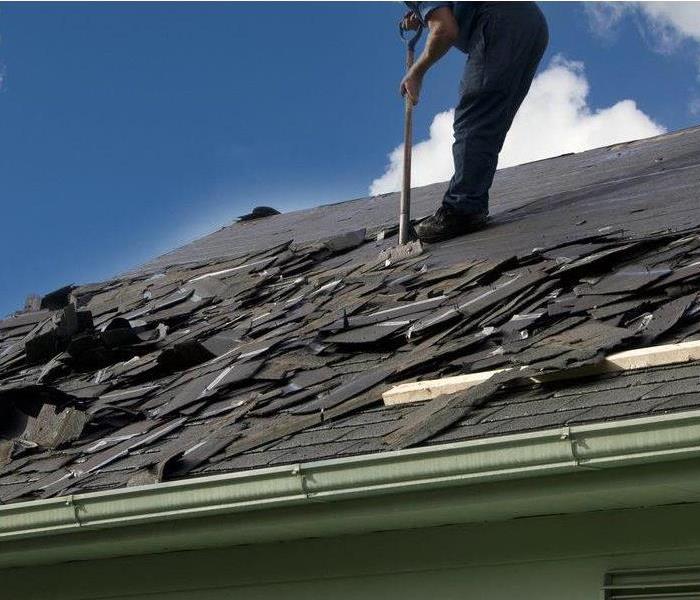 Storms can affect more than one area of your home. Make sure you are doing yourself a favor by knowing what to look for.
Storms can affect more than one area of your home. Make sure you are doing yourself a favor by knowing what to look for.
While some storms can be catastrophic and cause instant damage to your home, the losses may not be as significant in others. The Greenville, SC area has been known to experience thunderstorms, heavy rains, and tornadoes. Below are recommended areas to check after a storm strikes.
Roof
The roof of your Greenville home is most vulnerable to storm damages. Holes, split seams, leakage, missing or broken roofing materials are signs to look out for. You might also want to inspect the crawlspace area and the entire roof from top to bottom to determine if there are any damages.
Exteriors
The exterior of a home can take on a great deal of damage during a storm as well. The exterior may be durable, but not indestructible. Splitting, cracking, discoloration, dents, and holes are common signs of exterior property damage after a storm.
Doors and Windows
Winds and flying debris lead to cracks, damaged frames, broken glass, and holes in the doors and windows. Also, if you have window caps, shutters, or awnings, you’ll want to check for evidence of storm damage.
HVAC System
If you have a heating, ventilation, and air conditioning system in your Greenville, South Carolina home, do not forget to check it. Strong winds can also break off any outdoor part of the unit. So, make sure you have thoroughly inspected the HVAC system before turning it on.
Other Structures
If there are any other structures on and around your Greenville property, you’ll want to inspect their condition as well. Such as driveways, walkways, landscaping structures, fences.
Hurricane Survival and Preparedness
9/24/2021 (Permalink)
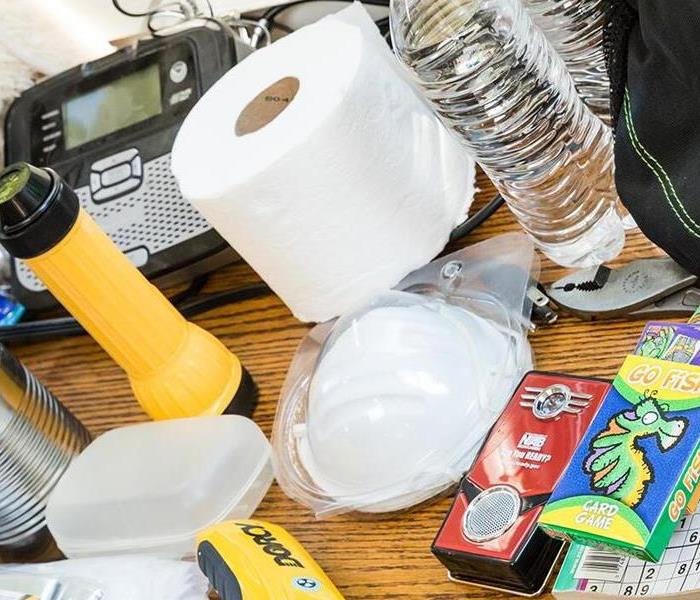 We want to help you prepare as much as possible to help protect you and your family.
We want to help you prepare as much as possible to help protect you and your family.
Living along the coastline is a dream for a lot of people.
It’s beautiful! there is also evidence that there is a link between living near the coast and pristine health!
Living on the coast has its ups and its downs. You should have a plan in place to prepare for severe weather, especially hurricanes.
Hurricanes are massive storm systems that form over the water and move toward land bringing high winds, heavy rain and hail, flooding, and more.
Hurricane Preparedness: What to Do Before a Hurricane
Before the storm is the time to start preparing your home and family for the worst. It’s better to overprepare than to be underprepared!
Hurricane Preparedness: What to Do During a Hurricane
Make sure you stay safe during a hurricane, whether you are evacuating or staying in your home.
- Evacuate when told to
- Stay Put In Your Home
- Unplug all the electronics
Hurricane Preparedness: What to Do After a Hurricane
After the storm, you can breathe a sigh of relief – but make sure you’re still staying safe! Even once the storm is over there are often hazards such as downed power lines and high water that can harm you and your family.
- Stay Safe
- Check-In
- Report hazards
- Stay away from floodwaters
- Be patient and stay positive
The most important thing to us at SERVPRO is to keep everyone safe!
Stay Safe During a Hurricane
9/14/2021 (Permalink)
 If you're in a hurricane and there are flood waters, TURN AROUND, DON'T DROWN! Six inches of water can knock you down!
If you're in a hurricane and there are flood waters, TURN AROUND, DON'T DROWN! Six inches of water can knock you down!
Hurricanes are dangerous and can cause major damage because of wind damage, storm surge, and flooding. They can happen along any U.S. coast or in any territory in the Pacific or Atlantic Oceans. Storm surge is historically the leading cause of hurricane-related deaths in the United States.
Stay Informed
- Pay attention to emergency alerts and information.
- If you live in a mandatory evacuation zone and local officials tell you to evacuate, do so immediately.
Dealing with the Weather
- Determine how best to protect yourself from high winds and flooding.
- Stay off bridges that go over fast-moving water.
- Take refuge in a designated storm shelter, or an interior room for high winds.
- If trapped in a building by flooding, go to the highest level of the building. Do not climb into a closed attic as you may become trapped by rising floodwater.
- Do not swim, walk, or drive through floodwaters. Turn-Around. Don’t Drown! Just six inches of fast-moving water can knock you down, and one foot of moving water can sweep your vehicle away.
Personal Safety
- If you must go to a community or group shelter remember to follow the latest guidelines from the Centers for Disease Control and Prevention (CDC) for protecting yourself and your family from COVID-19. Due to limited space, if you do not live in a mandatory evacuation zone, it is recommended that you shelter in place in your home.
- If you must evacuate, bring items to help protect yourself and others in the shelter from COVID-19, such as hand sanitizer, cleaning materials, and masks.
- If you are sick and need medical attention, contact your healthcare provider for further care instructions and shelter in place, if possible. If staying at a shelter or public facility, alert shelter staff immediately so they can call a local hospital or clinic.
- Only use generators outdoors and away from windows.
https://www.ready.gov/hurricanes
Steps to Take Immediately After a Storm Damage
8/28/2021 (Permalink)
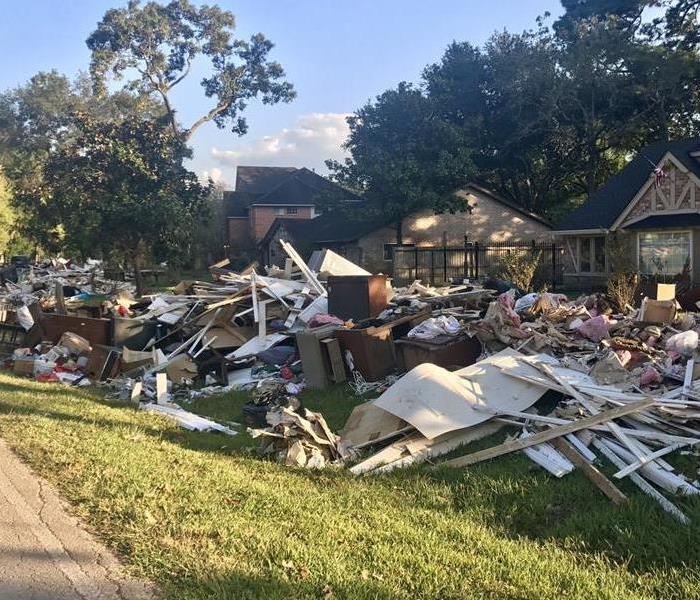 Have Storm or Flood Damage? Call Us Today (864) 292-3495
Have Storm or Flood Damage? Call Us Today (864) 292-3495
Storms are known to cause an immense amount of harm to your home. Some post-storm damage can create safety and health hazards as well. Having a strategy to help deal with these damages will help you to be ready to take steps immediately after the storm.
Take Safety Precautions
Collapsed roofing materials, window damage, and collapsed walls are all results of heavy winds. Let's not forget that moisture sometimes can soak into building materials and carpets to make the perfect environment for mold growth.
Photograph the Damage
Be sure to use your cellphone or a camera to photograph the damage so that you will have a record for your insurance company. This action will ensure that you are fully compensated.
Contact Your Insurance Company
Contact your insurance agent to notify them about the damage to your home immediately. The company will send out an adjuster to determine the extent of the damage so that payment for repairs can be made.
How Should Storm Damage Cleanup Be Handled?
8/23/2021 (Permalink)
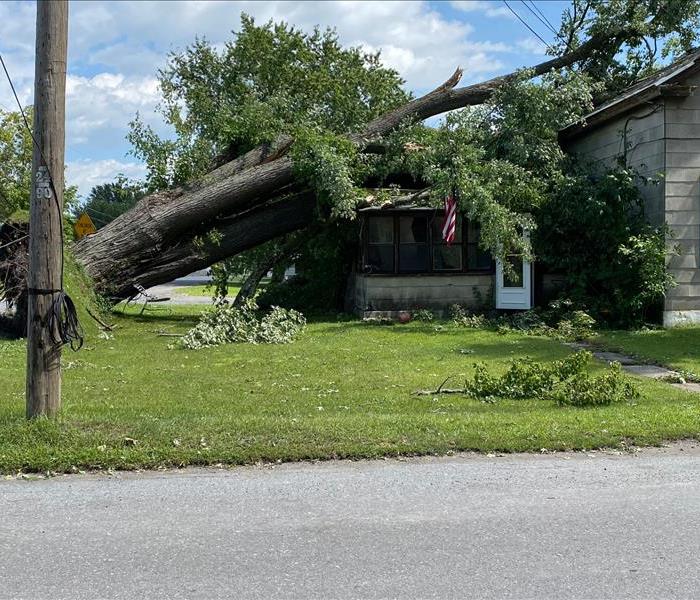 Trust the professionals when it comes to Storm Damage Clean-Up.
Trust the professionals when it comes to Storm Damage Clean-Up.
After a storm, it is important to try to minimize the impact that it has on your property. Unfortunately, storms can leave you dealing with a list of damages that must be handled properly to protect your safety and belongings.
Focus On Health and Safety
When dealing with water damage, it is important to first make sure that all power is shut off to the house. There is always a possibility that stormwater may have soaked into your walls and reached the electrical wiring.
Document the Damage
As soon as it is safe to enter your property, you will want to take photographs of the damage. These can be used as proof for your insurance company. Make sure to include both interior and exterior pictures.
Repair the Roof
Storms have a pattern of hitting the roof of homes and businesses the hardest. Make it a priority to have your roof inspected early on in your clean-up efforts.
Get Help With Water Restoration
If your property has been set for any length of time, it may be a necessity to do mold remediation. It only takes a matter of hours for certain types of mold to grow.
If you're looking for storm restoration services, then look no further than SERVPRO of East Greenville today.
Document Your Storm Damage
4/14/2021 (Permalink)
 Making a list of damaged items or areas, and even grabbing photos, is helpful after water damage, fire damage and storm damage!
Making a list of damaged items or areas, and even grabbing photos, is helpful after water damage, fire damage and storm damage!
Document, Document, Document!
When a storm rolls through your town, take a few moments to inspect your home. Performing a thorough inspection can save you a major headache. Our team at SERVPRO of East Greenville County wants to prepare you! Here are a few key places to inspect after a storm:
- Gutter Damage: Ensure they are attached, secure and clear of any debri/
- Drainage Areas: Check to make sure water is not follow toward your home, but away from it
- Ridge Vents Damage: after a heavy rain/wind storm, they love to come loose. Safely crawl to the top of your roof and gently push them down to ensure they are secure.
- Door Damage: Believe it or not, rain can come in through your door. The easiest way to keep this from happening is by redirecting any drainage away from your doors.
- Crawlspace Damage: Vents around your crawlspace, when not located high enough off the ground, can let water into your crawlspace. This can seriously damage the integrity of your home.
If you notice any of these problems occurring at your home, grab a few photos of them and contact our team today so we can assist, whether it be through a referral or through our services. We recommend you document any damages to your home should you need to get insurance involved. No matter the situation, we can help you!
Stay Connected!
4/1/2021 (Permalink)
 Social media, news websites and applications can let you know when a storm is approaching. Stay alert with the best apps!
Social media, news websites and applications can let you know when a storm is approaching. Stay alert with the best apps!
How do you stay connected? Do you use Twitter, Facebook, Instagram? What about The Weather App or your local new stations app? As storm season approaches, how fast we receive notifications of developing events is important. To help you get a jump start, we have listed two of the best ways to stay connected this storm season! Let us know what apps you enjoy using!
- Facebook - Follow your local news station to get the fastest notifications regarding storm events. When wild weather sweeps in and the power goes out, you can count on your local new station to be live covering the story.
- The Weather App - A live look at what is coming your way! Their radar and predictions are spot on. Staying up to date on their articles or videos can help you protect your home from impending dangers.
For more tips, check out our older blogs! Should you suffer any storm damage, get in touch with our team as soon as possible. We will do whatever we can to make it "Like it never even happened."
Your Commercial Property has Storm Damage. Now What? Part 4 | SERVPRO of East Greenville County
11/11/2020 (Permalink)
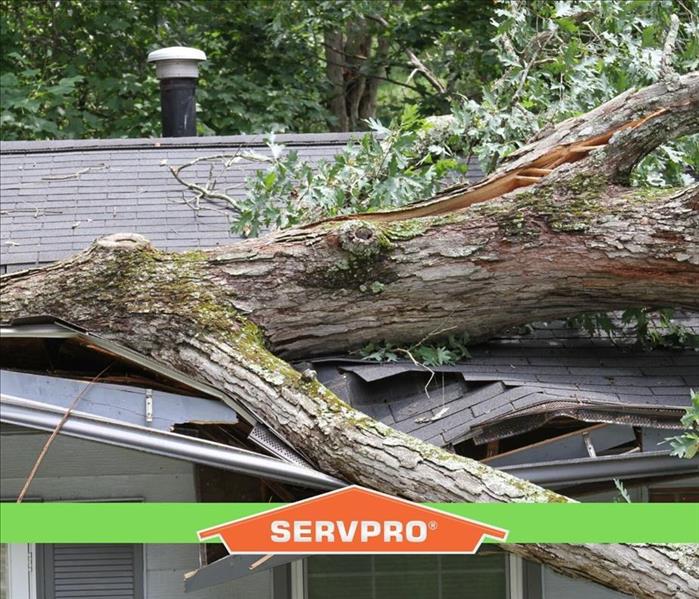 Storm Damage can make way for Water Damage & Mold Damage, and even Fire Damage if not dealt with properly & swiftly. Give our team a call today!
Storm Damage can make way for Water Damage & Mold Damage, and even Fire Damage if not dealt with properly & swiftly. Give our team a call today!
There are numerous situations where a commercial property might suffer extensive storm or water damage. Throughout the year, our team has been putting together steps for you to take to prevent storm damage at your commercial property. This is the last step we recommend, so give it a read and let us know if you applied any of these steps throughout the year!
Document Everything
Be sure to document as much as possible about the damage, its cause, and the steps needed to fix it while you’re busy inspecting and trying to repair the damage to your commercial property. It’s a good practice to do this because you may find you need to file an insurance claim for the cost of the repairs, and doing so without good documentation could result in the claim being denied.
Having a moisture meter that can store readings with a date and time stamp, then transfer the stored data into an easily-presentable report on your computer can be incredibly helpful. This provides documentation about the extent of the water damage and when it was first inspected – making it a little easier to help prove an insurance claim.
Additionally, taking photographs of the damage is helpful to further establish proof of the water damage.
If furniture pieces or building materials have to be thrown out, keep track of what is being disposed of as well. This may probe useful for determining the extent of your losses on an insurance claim. Water damage restoration experts recommend that you collect thorough documentation as well, since it helps them get paid by the insurance company.
These are just some of the basic actions to take if your commercial property suffers a water damage loss. While contacting a water damage restoration specialist is the best thing to do, following these helpful tips should help you mitigate the damage somewhat. As a basic rule of thumb, if the damage is severe enough to warrant filing an insurance claim, then you should probably hire an expert to handle the water damage cleanup.
There’s never a convenient time for water damage to strike your business. Every hour spent cleaning up is an hour of lost revenue and productivity. So when an emergency situation arises in your business, give SERVPRO of East Greenville County a call and we’ll be there fast with the help you need!
Have Water or Storm Damage?
Call Today – (864) 292-3495
www.delmhorst.com
Your Commercial Property has Storm Damage. Now What? Part 3| SERVPRO of East Greenville County
9/16/2020 (Permalink)
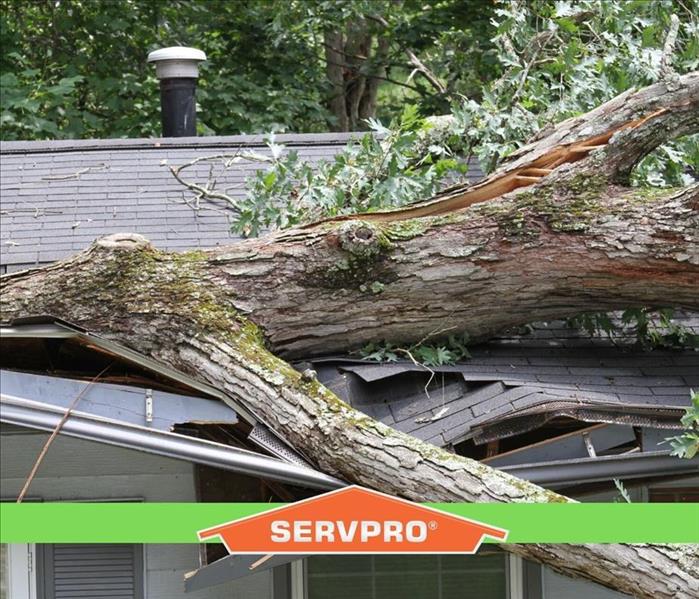 Storm Damage can make way for Water Damage & Mold Damage, and even Fire Damage if not dealt with properly & swiftly. Give our team a call today!
Storm Damage can make way for Water Damage & Mold Damage, and even Fire Damage if not dealt with properly & swiftly. Give our team a call today!
What do you do when you have a flood from storm damage, a pipe burst or a roof leak? Our team has come together to determine the first steps you should take to minimize the damage done by storm and water damage. Look back through previous blogs to find the first two steps! Continue reading to learn more about step three!
Drying Out the Affected Area
If you’re determined to handle the dry-out work yourself, or the extent of the damage is minor, then it may be possible to remove the moisture causing the damage on your own.
However, you’ll need a few specialized tools to make sure you can completely dry out the area, including:
- Air movers and/or dehumidifiers to extract the humid air
- Pin and/or pointless moisture meter to track the moisture content of the building materials
- Wet vacuums to remove standing water quickly
- A thermo-hygrometer to track the humidity in the room
If the structure has a climate control system, then turning up the temperature slightly can help to keep water from becoming condensed – allowing dry-out work to proceed just a little bit faster.
When drying out a room in a building that has experienced flood damage, it’s imperative to keep the building as sealed against exposure to outside air as possible. Otherwise, mold spores and other contaminants can work their way inside and, with the help of the excess moisture in the structure, begin to spread. Any air movers attached to an opening should be sealed in place in such a way that they constantly force air out and prevent outside air from getting in.
Any moisture-compromised furniture should be assessed and removed. If it is too water damaged, it will need to be thrown away and replaced. The same goes for any building materials in the affected area.
Have Water or Storm Damage?
Call Today – (864) 292-3495
www.delmhorst.com
Your Commercial Property has Storm Damage. Now What? Part 2 | SERVPRO of East Greenville County
7/22/2020 (Permalink)
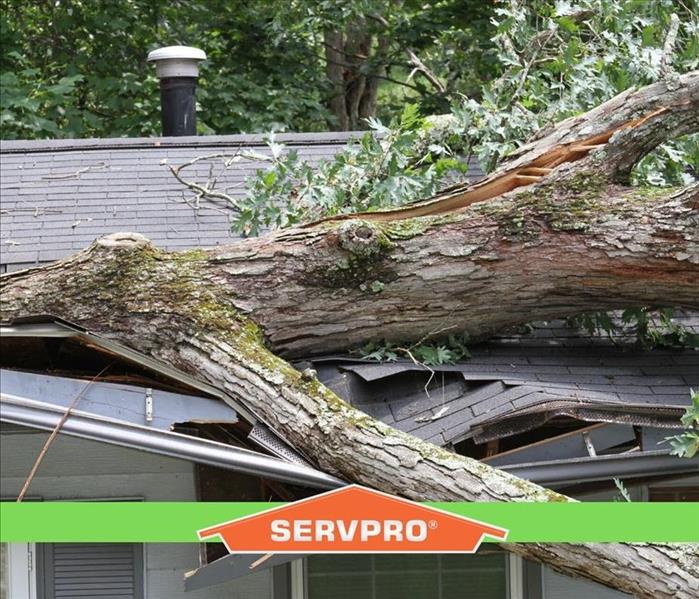 Storm Damage can make way for Water Damage & Mold Damage, and even Fire Damage if not dealt with properly & swiftly. Give our team a call today!
Storm Damage can make way for Water Damage & Mold Damage, and even Fire Damage if not dealt with properly & swiftly. Give our team a call today!
A burst/leaky pipe causes water to collect in the spaces between walls or floors in a structure which can lead to mold growth. A flood from a storm or overflowing river bank might deposit massive amounts of dirty water all over the first floor of a structure. Now what?
Contacting a Water Restoration Expert
It may be a good idea to contact a water damage restoration expert to handle the task of dry-out/tear-out for you if you’re inspecting your own property and do not have experience in water cleanup/restoration work. This is because water damage remediation work can be too dangerous or delicate for someone without specialized training or experience to handle.
For example, a professional in water damage restoration will have the appropriate experience and tools to minimize their risks from hazards such as mold spores, weakened floors that may collapse, and exposure to fiberglass insulation – all of which are common hazards in water cleanup and restoration work. Additionally, an expert is more likely to be able to successfully complete dry-out tasks in a way that minimizes cost and the overall damage and risk of future problems. Trying to handle tear-out and dry-out work without the requisite and experience can lead to big problems – not the least of which is accidental injury from handling damaged building materials.
Have Water or Storm Damage?
Call Today – (864) 292-3495
www.delmhorst.com
Your Commercial Property has Storm Damage. Now What? | SERVPRO of East Greenville County
5/27/2020 (Permalink)
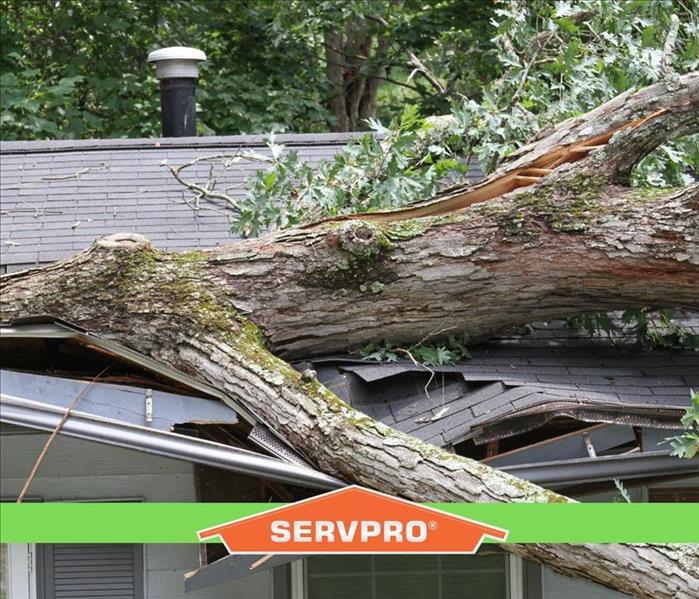 Storm Damage can make way for Water Damage & Mold Damage, and even Fire Damage if not dealt with properly & swiftly. Give our team a call today!
Storm Damage can make way for Water Damage & Mold Damage, and even Fire Damage if not dealt with properly & swiftly. Give our team a call today!
There are numerous situations where a commercial property might suffer extensive storm or water damage. For example, a burst/leaky pipe causing water to collect in the spaces between walls or floors in a structure that can lead to mold growth or a flood from a storm or overflowing river bank might deposit massive amounts of dirty water all over the first floor of a structure.
Whether it’s flood water damage or some other form of moisture intrusion, here are guidelines to follow if you’re inspecting your building for water damage.
Confirm the Extent of the Damage
One of the first things you’ll want to do if you discover signs of water or storm damage is verify the extent of the damage. A simple visual check probably won’t be enough to reliably establish the full scope of the problem.
Unfortunately, water can soak into many building materials far from the source of the moisture intrusion without causing any obvious signs for quite a long time. To accurately measure how far the water has spread, you need a specialized tool such as a moisture meter for building inspection.
When using a moisture meter, you can measure the moisture content of the materials where you noticed the water damage. While continuing to make checks progressively farther away from the original site of damage, you can establish how widespread the damage is as well as determine the severity of the moisture intrusion.
With this information gathered, you can determine whether you need to focus on drying out the affected areas, or simply tear them out so they can be replaced with undamaged material.
Have Water or Storm Damage?
Call Today – (864) 292-3495
www.delmhorst.com
Calm Before The Storm | SERVPRO of East Greenville County
4/23/2020 (Permalink)
 Taking precautions protect you and your home. Have Storm Damage or Water Damage? Give our team a call at 864-292-3495
Taking precautions protect you and your home. Have Storm Damage or Water Damage? Give our team a call at 864-292-3495
Dangerous storms have been appearing in the forecast more and more lately. There is the old saying which goes, “April Showers will bring May flowers.” If that is true, May should be a month covered in flowers! April is not over yet, and storms do not only happen in April though, so you should still be fully prepared. As mentioned in our last Storm Damage blog, there are measures you can take to protect your home. You should always be prepared for storms to keep your family safe too. Learn more about that by reading our blog “How to prepare for Spring Weather.”
Storms are very unpredictable, so being ready and taking precautions is necessary. What other precautions should you take to ensure the safety of your home and family? Here are a few our team at SERVPRO of East Greenville recommends:
- Clean out your gutters. - A full gutter can hold water and create rust in the side of your roof's fascia board, which will lead to large damage to your home if not monitored.
- Check for any hanging limbs near your home. - Falling limbs, depending on the size, can damage your windows, siding, and gutters.
- Do you have any cracks in your foundation? - Water can slip through the smallest places. Check your foundation regularly for cracks or holes. Where there is a place for water to enter the crawlspace, there is a place for mold damages to occur in your crawl space.
As you check your home regularly and should you gather concerns, give our team at SERVPRO of East Greenville County. We will assist you as best we can with your concerns or mitigation needs. Taking all of these steps are the best way to protect what you work hard for every day.
How To Protect Your Roof - Preventative Storm Damage Checklist
4/14/2020 (Permalink)
 If you have any storm damage, SERVPRO of East Greenville County is here to help. We are available 24/7 and ready to assist you when you need it
If you have any storm damage, SERVPRO of East Greenville County is here to help. We are available 24/7 and ready to assist you when you need it
Being a homeowner comes with a long list of responsibilities. Different areas of your home require more or less attention depending on the space. Potentially, the most important area of any home is the roof. It protects your home from harsh storms, hail, fallen debris and more. For this reason, conducting a roof inspection regularly is a great preventative measure to guarantee your roof is intact and in good condition.
Review this checklist so you know what red flags to look for.
- Shingles that may be missing, moved, bent, curling or blistering.
- Identify flashing and rubber boots, then check for cracked caulk or rust spots.
- Look for masses of moss, as this could reveal your roof is decaying from underneath.
- Debris build-up in your gutters.
If any of the problems mentioned are found on your roof, your home is at risk. These problems give way for water damage, storm damage and eventually mold. Weather does not wait for normal business hours to cause damages. Whether your damages occur during the middle of the night or in the middle of your lunch, our team at SERVPRO of East Greenville has trained storm, water and mold specialists ready to respond when you need them most. Always take preventative measures, but rest assured we can make it seem "Like it never even happened."
How to prepare for Spring Weather?
4/1/2020 (Permalink)
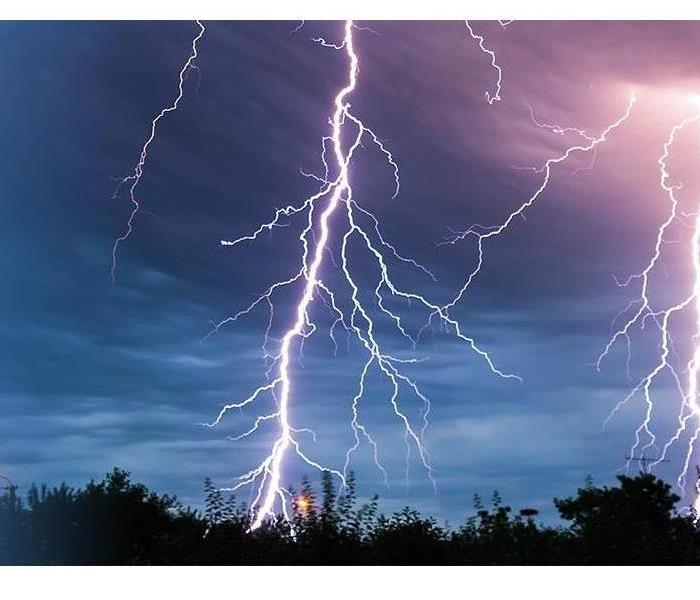 Prepare for Severe Spring Weather before it surprises you.
Prepare for Severe Spring Weather before it surprises you.
Spring weather is often unpredictable. Temperatures can change quickly and sunny days can be followed by a week of stormy weather. The risk of injury and even weather-related deaths can increase when severe weather hits unexpectedly. It is important to prepare for tornadoes, floods and storms prior to their arrival, because in the spring they can surface quickly.
Whenever warm, moist air collides with cool, dry air, thunderstorms can occur. Thunderstorms bring with them lightening, flooding and even tornadoes. They are the cause of most of the severe weather in the spring. Often when we are aware of an approaching storm it is to late to prepare for it. It is important to have a plan in place for every type of severe weather and practice this plan. Planning in advance for severe weather should also include keeping an emergency kit on hand.
Items to include are:
- A battery-operated flashlight with extra batteries
- A battery-operated weather radio
- A list of important personal information including neighbors, family and friends, insurance and property information and medical information
- First Aid Kit
- Medications
- 3-5 day supply of non-perishable food and bottled water
- Blankets and sleeping bags
Communication is critical to having a successful plan in place. Make sure your family members know to seek shelter in the event of a storm.
Unfortunately, storms will surface preparing for them in advance will take the surprise out of storm.
Sources:
http://www.cdc.gov/features/springweather/
https://itsadisaster.wordpress.com/2012/12/27/tornadoes-dont-usually-happen-in-december-or-do-they/
How to prepare your Greenville, SC home for a Winter Storm before it arrives
12/5/2019 (Permalink)
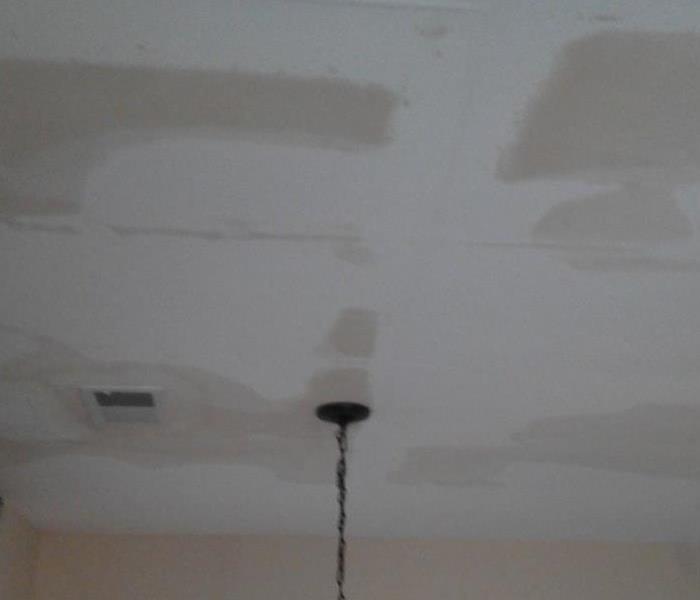 SERVPRO of East Greenville responded to a Water Damage from a busted pipe during a winter freeze that caused damage to the ceiling a breakfast room
SERVPRO of East Greenville responded to a Water Damage from a busted pipe during a winter freeze that caused damage to the ceiling a breakfast room
One of the best and safest places to stay during a winter storm is in your home. It is important to remember that there is more to protecting your home and family than stocking the refrigerator with the essentials like bread and milk. Following the tips below will help protect your home when a winter storm strikes.
- Many homes have exposed pipes in the attic, crawlspace or basement. These areas are unconditioned and get much colder that other areas of your home. Remember to keep these pipes warm, you can wrap then with a material to help insulate them from dropping temperatures.
- It is also important to remember to open cabinet doors in bathrooms and kitchens that have sinks with plumbing underneath to allow warm air to circulate. When cabinet doors remain closed, the temperature can become much colder and can make these pipes susceptible to freezing.
- Finally let the water drip slowly from a faucet in your home to keep the water flowing and to help protect your pipes from freezing.
Following these tips will help protect your home when a winter storm strikes.
In the unfortunate event that you suffer from a Water Damage due to a frozen pipe during a winter storm, SERVPRO of East Greenville County is always here to help. Our technicians are highly trained in handling water damage mitigation and will be ready to assist you when an emergency happens in your home.
https://www.SERVPROeastgreenvillecounty.com/emergency-restoration
When Storms or Floods hit Greenville, SC. SERVPRO is ready!
11/25/2019 (Permalink)
 SERVPRO of East Greenville team member's are ready to help in the event of a storm in Greenville, SC.
SERVPRO of East Greenville team member's are ready to help in the event of a storm in Greenville, SC.
SERVPRO of East Greenville County specializes in storm and flood damage restoration. Our crews are highly trained and we use specialized equipment to restore your property to its pre-storm condition.
Faster Response
Since we are locally owned and operated, we are able to respond quicker with the right resources, which is extremely important. A fast response lessens the damage, limits further damage, and reduces the restoration cost.
Resources to Handle Floods and Storms
When storms hit Greenville, SC we can scale our resources to handle a large storm or flooding disaster. We can access equipment and personnel from a network of SERVPRO Franchises across the country and elite Disaster Recovery Teams that are strategically located throughout the United States.
https://www.SERVPROeastgreenvillecounty.com/disaster-recovery
Have Storm or Flood Damage? Call Us Today 864-292-3495!
Thunderstorm Awareness
9/18/2019 (Permalink)
Hurricane season is approaching and even though we’re in the upstate we feel the effects of the coast. Heavy rains from a thunderstorm can cause flash flooding, and high winds can damage homes and cause severe damage.
The most important part about preparing for storms is educating yourself on what to do before, during and after thunderstorms. Know the difference in a thunderstorm watch and a warning to take the proper precautions.
Severe Thunderstorm Watch: Severe thunderstorms are possible in and near the watch area. Stay informed and be ready to act if a warning is issued.
Severe Thunderstorm Warning: Severe weather has been reported by spotters or indicated by radar. Warnings indicate imminent danger to life and property.
Learn your local community emergency warning system. It’s best to have plans in place to make sure, in case of an emergency, you are prepared.
Preparing for Thunderstorms:
- Communicate with members in your household or business thunderstorm and lightening safety
- Pick a area in your home of business to gather during a thunderstorm. Make sure this is away from glass windows or glass doorways
- Consider specific needs in your household or business. Age, Disabilities, and/or any pets? If there are animals ensure that outside buildings that protect them are secured
- Put together a kit with necessities in case of an emergency like water, flashlights, portable chargers, a first aid kit and blankets
American Red Cross has a downloadable Emergency app for iPhone and Android that provides weather alerts, map with open Red Cross shelter and an in-app toolkit.
This season, we our community will be ready and prepared thanks to SERVPRO OF East Greenville.
Watch VS Warning: A Cautionary Tale
4/15/2019 (Permalink)
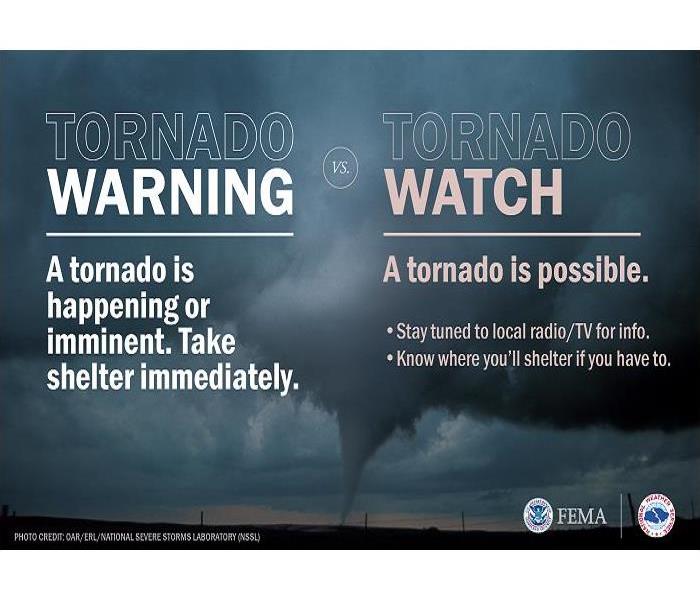 The differences between a watch and a warning are drastic when dealing with tornadoes. Make sure your family understands them.
The differences between a watch and a warning are drastic when dealing with tornadoes. Make sure your family understands them.
I was eights years old when Hurricane Hugo tore through the Upstate of South Carolina. It was one of the scariest days of my life. My mother and I lived in a trailer at the time, and I could hear the wind rattle the walls over the sound of the rain pounding the metal roof. The power was out, and we were listening to a battery-powered radio, as it repeated the various warnings and watches across the area. The announcement came over about a severe storm warning and a tornado watch for the area we lived in. My mom said we would be fine. Less than 30 mins later we were now under a tornado warning. We began scrambling to gather our pets and get in the car to drive to our neighbors’ house, but we were too late. A roaring train sound came through, and everything began to shake. My mom grabbed me, and we ran into the bathroom and jumped in the tub. When suddenly we were flipped.
Our trailer had been flipped over, and it could have been much worse if not for the pins that did hold. But it was over quickly and those few moments are a blur. Our home was all but destroyed after whatever hit us passed, my left arm was broken, my mother had a few broken ribs and a bad cut, and our pets didn’t survive.
I did not share this story for sympathy, instead to help show the importance of understanding what a watch or a warning means when it comes to severe weather. Had we taken action when the watch was issued, things may have happened differently.
Tornado Watch: Tornadoes are possible in and near the watch area. A watch area may be vast, spanning several counties and sometimes states. If a watch is issued in your area, start to prepare for severe weather. Check to make sure that there are supplies and that the designated safe area is ready, as well as confirm that everyone understands the plan.
Tornado Warning: A tornado has been spotted or indicated by radar inside the designated warning area. Warning areas are smaller and have shorter time intervals than watches. If a warning is issued for your area, take action and seek shelter immediately. Keep updated with weather alerts to be certain when the warning has expired.
Please learn from my experience and make sure that your family or coworkers understand the difference between a watch and warning, and make sure to have a plan in place.
Downspouts: Saving Your Property for Centuries
3/18/2019 (Permalink)
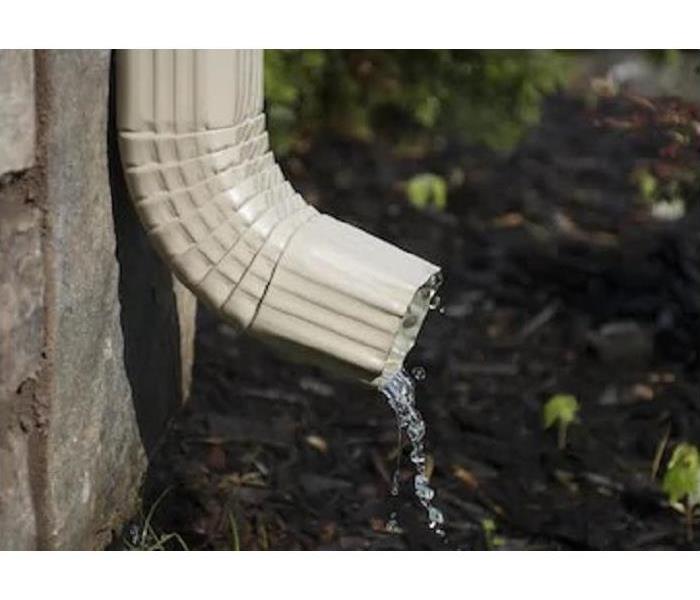 A downspout is a great way to prevent rainwater from saturating the ground next to your property.
A downspout is a great way to prevent rainwater from saturating the ground next to your property.
If you are like me, the sound of pouring rain is very relaxing, almost nap-inducing. But have you ever heard it sound like that you are in the middle of a monsoon and look out the window to see that it is only a light drizzle? Your gutters may be overflowing causing water to pool against your foundation. Now if this sounds familiar, we do have a previous blog touting how important it is to take the time to care for your gutter. Now, this blog is dedicated to the Downspout, one of the true heroes of preventing water damage in your basement or crawlspace.
A downspout is a vertical pipe that attaches to your property’s gutters and navigates the flow of water off of a roof and away from the base of your home. Sometimes a downspout is connected to a yard drainage system or sewer, but most redirect the water into the ground to be absorbed. Downspouts are centuries old; it is believed that the first water spout was built in 1240. They became part of one of the most intriguing features of gothic architecture, the gargoyle, decorative stone carvings and statues built onto the walls and roofs, with the statue’s mouth acting as the downspout to protect churches and castles from erosion. In fact, in architecture terms, the word gargoyle only applies to figures that serve as downspouts, all other stone carvings of creatures that are solely for decoration are referred to as a “grotesque.”
Modern downspouts not only prevent erosion, but they also prevent water from depositing against a structure and potentially entering via wicking, cracks, and other entryways like crawlspace doors. A finished basement can flood, damaging the floors, walls, and furniture. Standing water in crawlspace can elevate moisture levels, increasing the chance for microbial growth and negatively affecting the air quality inside your home. That is why it is important to make sure that your gutters are free of debris, and why you should put a significant amount of thought into how you design your flowerbeds that are close to your home. Checking the gutters after a severe storm can help catch debris from clogging a gutter or downspout, and that can prevent rain from overflowing from the gutters and depositing near your foundation. You might inadvertently create a dam out of mulch, forcing the water to pool too close to your home and cause the issue that you are trying to prevent. You can also purchase attachments that will extend the pour point and give you more control of where the water flows out of the downspout.
There are multiple ways that you can protect your home or property’s crawlspace, foundation, and basement. And having a well placed and maintained downspout is a fantastic addition to your arsenal.
If water from excessive rain and any other reason has flooded your basement or crawlspace, call the SERVPRO of East Greenville County team at 864-292-3495. We are #Ready to provide you with mitigation services and help you make it “Like it never even happened.”
South Carolina Severe Weather Preparedness Week
3/11/2019 (Permalink)
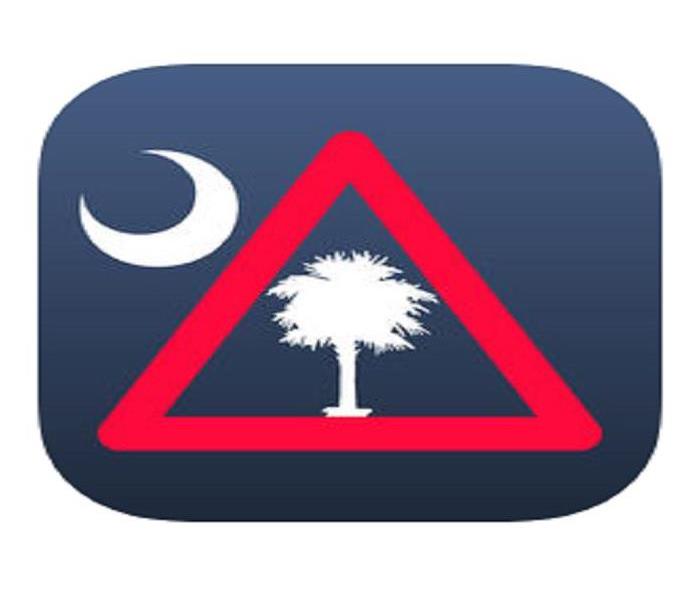 The SCEMD app is a great tool that allows users to create plans and stay up to date on weather alerts.
The SCEMD app is a great tool that allows users to create plans and stay up to date on weather alerts.
March 10th through the 16th is Severe Weather and Flood Preparedness Week in South Carolina. The week is designed to reinforce that severe storms, tornadoes, and floods can have a significant impact on our state, and as residents, we need to take the proper safety precautions. The National Weather Service and the South Carolina Emergency Management Division (SCEMD) co-sponsor the week to promote awareness of the procedures that can help keep you safe during severe weather.
Meteorologists can track weather patterns to predict severe thunderstorms and flooding, but tornadoes are much more difficult to anticipate, and warnings may only be issued within minutes before striking. That is why it is essential to develop and practice an Emergency Action Plan at home and work in order to be as prepared as possible in the event of a tornado. Participating in tornado drills will help ensure that your family and co-workers are on the same page and know what action to take as well as their roles afterward. On Wednesday, March 13th at 9 AM there will be a statewide tornado drill, along with broadcast stations testing their emergency alert systems.
In South Carolina, the majority of tornadoes occur between March and May, but the ideal conditions for a tornado can happen at any time. That is why the National Weather Service has provided the following advice:
Before a Tornado
- Be alert to changing weather conditions.
- Listen to NOAA Weather Radio or commercial radio or television newscasts for the latest information.
- Look for approaching storms.
- Look for the following danger signs:
- Dark, often greenish sky
- Large hail
- A large, dark, low-lying cloud (particularly if rotating)
- Loud roar, similar to a freight train
- If you see approaching storms or any of the danger signs, be prepared to take shelter immediately.
During a Tornado
- If you are under a tornado warning, seek shelter immediately.
- Get indoors to a pre-designated shelter area such as a basement, storm cellar or the lowest building level. If
there is no basement, go to the center of an interior room on the lowest level (closet, interior hallway) away
from corners, windows, doors, and outside walls. - If in a vehicle, trailer or mobile home, get out immediately and go to the lowest floor of a sturdy, nearby
building or storm shelter. - If unable to get indoors, lie flat in a nearby ditch or depression and cover your head with your hands. Be
aware of potential flooding and flying debris. - Never try to outrun a tornado in your vehicle. Instead, leave the vehicle immediately for safe shelter.
After a Tornado
- Use the telephone only for emergency calls.
- Avoid downed power lines and report them to your utility company.
- Stay out of damaged buildings.
The SCDME also has an application to help you prepare and keep up to date during severe weather conditions. It is available for iPhone and Android operating systems.
How You Can Help Prevent Your Pipes From Freezing
12/6/2018 (Permalink)
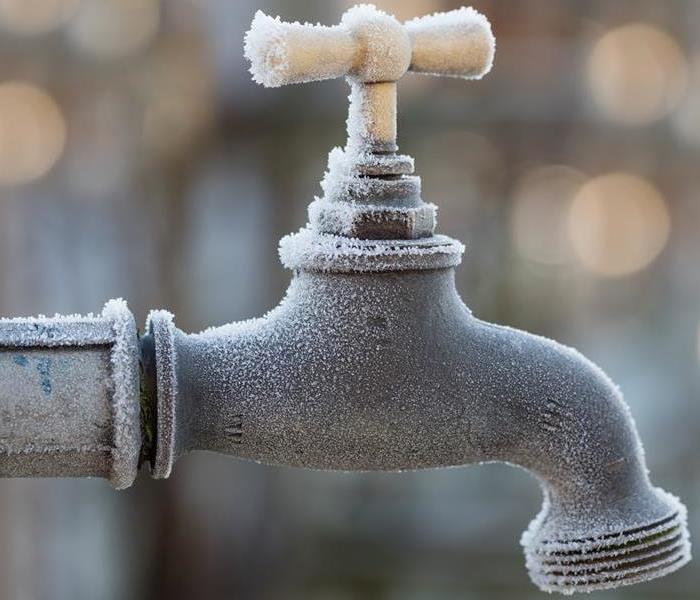 A frozen over outside faucet can be a bad omen for your Greer, SC property. Make sure to take steps to protect your plumbing, inside and out.
A frozen over outside faucet can be a bad omen for your Greer, SC property. Make sure to take steps to protect your plumbing, inside and out.
Winter is coming. (Always wanted to say that in the right context.) And it is coming to the Greenville, SC a few weeks early. A blast of cold air is headed our way, and although there is uncertainty for ice or snow, one thing that is for sure is that temperatures are going to drop. Meteorologists are predicting lows in our area to be in the 20s for a few days next week, and the highs are not much warmer. So, make sure to stock up on bread, milk, batteries, and board games. But don’t forget to prep your pipes.
As a water damage mitigation company, we see a barrage of water losses during winter weather events. And these particular loses come with their own unique set of challenges, water from burst pipes can spill into a home and freeze or the power may be out for days. But the SERVPRO of East Greenville Team has the training and equipment to overcome these challenges and help you and your property recover quickly.
But that doesn’t mean that we can’t share some tips on how to help prevent pipes in your home, business, or facility from freezing and possibly causing major problems.
Keep your thermostat set at the same temperature during the day and night. If you grew up with a penny-pinching family member you might remember phrases like “Turn the heat down during the day, the sun will keep us warm,’ or “Turn the heat down at night and use extra blankets and put on two pairs of socks to keep warm.” My uncle said those exact statements frequently and many times during the same day. But trying to save a few cents can wind up costing a lot. It is a good idea to keep a warmer temperature consistent to help keep indoor pipes from getting too cold. Speaking of…
Open cabinet doors to allow warm air to circulate around indoor plumbing. Keeping indoor pipes warm can prevent them from being the culprits if you do have a pipe burst, and that can limit the damage to crawlspaces or the exterior of the home. Make sure to put any harmful chemicals out of reach of small children or pets.
If you are planning to spend the cold weather somewhere other than home, set your thermostat to 55° or higher, you may not be at home, but your pipes are.
Use insulation to protect pipes in basements, crawlspaces, attics, and the exterior of your home. Insulation tape and water faucet covers can help protect any external faucets, just make sure to disconnect the hose for maximum protection. If a few items at $5 can prevent spending $1000s, sign us up. These can work in the short term, but you may want to contact a professional to install long-term insulation to your pipes under a house or in a basement or attic.
Turn the faucet on. You hear it a lot, but it works. Moving water is harder to freeze than still water. Even a slow drip can be enough to make a huge difference. Running the water in multiple rooms can help even more.
We hope that these tips are helpful, and if you have any additional best practices that you’d want to share, head on over to our Facebook and leave us a comment.
Essential Items to Keep in Your Vehicle During Greenville’s Winter Months
11/26/2018 (Permalink)
 Getting stranded during a winter storm can be a dangerous spot to be stuck in. Make sure that you are prepared if you have to be on the road.
Getting stranded during a winter storm can be a dangerous spot to be stuck in. Make sure that you are prepared if you have to be on the road.
While it is true that we do not get a significant amount of winter weather here in Greenville, SC, when we do get it everything shuts down. Well almost everything, thanks Waffle House. Our area is notorious for false start winter storm warnings, empty bread aisles and milk shelves, and school cancelations. Just to get cold rain. And because of this, many folks around the area do not heed the warnings so when we do get a 4-inch blizzard, or even worse an ice storm, they are caught unaware, especially on the road.
Getting caught in heavy snow or ice while driving can be a challenge, after all, the Upstate does not get enough of it to become adapted to those conditions. And many facilities may hold off on closing or sending employees home until conditions are no longer safe to drive. You’ll see 85 and 385 dotted with abandoned vehicles the day after a winter event and you hope that everyone is OK and be happy that was not you.
But what do you do when it IS you? Do you chance it and walk a mile or two in the snow or ice, what if you have children or those with mobility issues? You may have to stay in the vehicle until conditions clear up, if they are clearing up soon. And that is why keeping the following items in the car during the winter months is a fantastic idea that can help to keep you and your family safe.
Flashlight: Keeping a flashlight in your car is always a good idea no matter what season, but if you are stuck during a winter storm you can use the flashlight to get the attention SHEP trucks or other good Samaritans and save your cell phone battery for trying to call for help. Speaking of which…
Cell phone battery pack: Having an external cell phone charger handy is a life saver. You may have to call for help or use GPs to locate a safe place to wait out the storm. These can be a little tricky because you do have to remember to keep them charged and put them back in the car too, but are still worth the investment.
Gloves, an extra set of warm clothes, and blankets: You may have to get out and push or try to dig out of a bad situation if you slide off the road. The gloves will keep your hands warm, but if there is still precipitation falling or deep snow having an extra set of clothes to change into can help prevent possible health concerns like frostbite or hypothermia. Depending on your situation you may be there a while, blankets will help keep you warm.
Kitty litter: Find the coarsest kitty litter you can and keep a bag or two in the trunk, but stay away from the scoopable variety. You need the rough litter to help give your tires traction if you are stuck. Spreading the litter near your tires and in front of the vehicle can help you to get out of a potentially dangerous scenario.
Reflectors, reflective clothing, and road flares: Visibility may be limited during, and after a storm, flares can help get others attention, the reflectors will help others to see your vehicle, and if you are risking the walk, reflective clothing like a vest can help other drivers to see you and avoid accidents.
Tow rope or chain: Remember the good Samaritans from earlier, they have stopped to help you but they do not have a way to help pull you out of the ditch and pushing is not working either. If their vehicle is built for working, they may be able to pull you out of the ditch. Just be sure of where to safely tie the chain or rope to both vehicles. (If you have a cell phone battery charger and are still have a signal you can look up the optimal spots on each car is for emergency towing.)
Water and non-perishable food: Being stranded is not fun, being stranded and hungry and thirsty is even less fun. Keeping water along with granola bars, jerky, or trail mix will give you the calories you need to stay warm. And if you have children with you, a snack can stave off crankiness and prevent a bad situation from getting worse. Just don’t eat out of boredom or stress eat, and check the expiration dates on your items.
There are many more things that you can keep in your car for the winter months, or all year (*cough cough* first aid kit) based on where you live. These are just a few ideas from our team based on some real-life experiences that we hope you never need but will be happy that you have.
Rapid Response to a Storm Event at a Greenville, SC business.
8/14/2018 (Permalink)
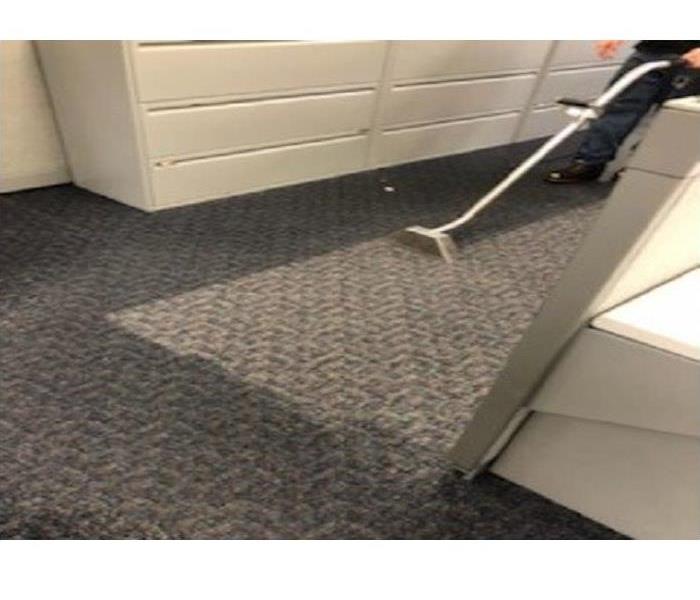 A water extraction in progress. It pulls water from a carpet before it can absorb into the padding.
A water extraction in progress. It pulls water from a carpet before it can absorb into the padding.
Over the past few weeks, the Upstate received several inches of rain. Single day totals were broken in some cities and flash flood, and storm warnings were a daily occurrence. The final days of the deluge proved to be too much for a roof of a Greenville business as a small section of their roof gave way to a significant amount of water.
The office had closed for the weekend, but the water was pouring in and rushing across the floor so rapidly that it set off the motion detectors and a manager was alerted. (Which is lucky for them, because if this amount of water had sat for the entire weekend, there is no telling how much damage could have been done.) The business had used SERVPRO of East Greenville County for commercial cleaning services in the past and knew that we were the people to call for this emergency. Almost every member of our production crew was on site in less than two hours to start the water extraction and drying process. All the standing water was removed
The office space is over 20,000 square feet and is requiring 140 air movers, over a dozen dehumidifiers, and scores of man hours to get this business back into a working state. As of this posting, we expect the flooring to reach dry standard by August 15, and we will then begin inspecting for any secondary issues that can arise from water damage.
SERVPRO of East Greenville County is always ready to help your business recover as fast as possible to limit downtime and reduce the loss of productivity and profit. If your home or business experiences any disastrous event, give us a call at 864-292-3495, and we will be there to help you.
Being Proactive to Reduce Storm Damage in Greenville, SC.
6/28/2018 (Permalink)
 Maintaining the trees on your Taylors property can help to limit the damage from severe weather.
Maintaining the trees on your Taylors property can help to limit the damage from severe weather.
This last week has seen severe thunderstorms pop up every afternoon in Greenville and the surrounding areas. Many of the late night and early morning news broadcasts have updates about the number of power outages or damage to homes, business, and churches across many counties in the Upstate. It is impossible to predict what impact a storm may have on your property, flooding, damaged roof, shattered windows, etc., but you can be proactive to limit the damage caused by the trees around your property.
Factors like the density of the canopy, the strength of the branches, and health of the root system need to be considered when preparing the trees on your property for any severe weather. And you can take steps to control these factors.
Pruning
Maintaining a tree can make a significant difference on if a tree survives a storm. Pruning the canopy – or the top of the tree- will reduce wind resistance and reduce the force that can damage limbs or the tree trunk causing the tree to topple over. Pruning can also remove dead or dying branches that have a much higher chance of being torn from a tree and causing damage to property. Having the trees on your property pruned may seem costly at first, but it can help to reduce or avoid damage that may have a much higher cost.
Mulching
Mulching isn’t just to improve curb appeal; it can also protect the root system of a tree. Having a wide “mulch” ring around a tree’s base prevents water from flowing away from the roots of the tree, allowing it absorb into the soil and nourish the tree. And since a trees root system can spread out for yards around a tree, the mulch ring puts distance between the tree and yard equipment like mowers, minimizing the damage that occurs when a mower blade nicks an exposed root.
If you have concerns about the condition of the trees around your Greer property or want to be proactive to prevent storm damage, contact a professional arborist. Reducing the likelihood of storm damage is a great way to reduce its cost.
Volcanic Impacts to Greenville, SC Weather
6/4/2018 (Permalink)
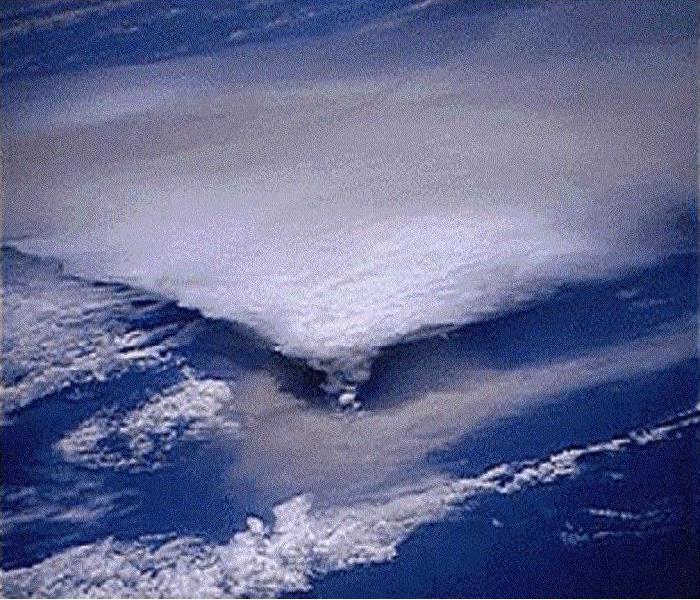 Winds can spread the discharge from a volcano hundreds of miles, causing impacts to the weather for months.
Winds can spread the discharge from a volcano hundreds of miles, causing impacts to the weather for months.
There has been a significant amount of volcanic activity in the news recently, between Hawaii’s Mt. Kilauea and Volcán de Fuego in Guatemala. And even though they are thousands of miles away, there is a possibility that they, especially Fuego, may impact the weather here in the Upstate.
While volcanologists are not 100% sure how much and eruption can impact the weather long term or long distance, they are starting to get a much clearer picture. They have determined that the size of the particles dispersed into the layers of the atmosphere can cause the Earth to heat or cool. If the particles are larger than 2 microns, they let the radiation from the Sun in but block the heat from the Earth from escaping, leading to warmer temperatures (an expedited Greenhouse Effect). If the particles are smaller than 2 microns can block the Sun and cause the Earth to cool. (OregonState.edu)
How this can affect us locally will be determined by the output from Fuego and how that impacts the waters in the Gulf of Mexico. If the particles prevent the heat from escaping the Earth, they can cause the temperatures to rise in the Gulf, and that includes the water temperatures. The warmer water can lead to more instability and produce more or stronger storm systems to develop. And as we just witnessed with Alberto, storms that come up through the Gulf can have a devastating impact on our region. This may call for meteorologists to reevaluate their predictions for the 2018 Atlantic Hurricane Season.
But you do not have to wait to see if we are impacted to take action to help those that are affected right now. You can contact the American Red Cross to how you can help those in Hawaii and reach out to the International Committee of the Red Cross on how you can aid those in Guatemala.
The “Official” Start of Hurricane Season
6/1/2018 (Permalink)
 You can build your own disaster survival kit or purchase pre-made kits from many sources including the American Red Cross.
You can build your own disaster survival kit or purchase pre-made kits from many sources including the American Red Cross.
While we did get a head start with Tropical Storm Alberto, the Atlantic Hurricane Season officially begins today. Over the past few weeks, the outlook for the season has changed from below average to now near average. And while it can be tough predicting several months’ worth of weather events, it is very easy to get prepared.
The Upstate may not have to worry about many of the dangers of a hurricane, but if you have been here long enough to remember Hugo, you know that things can get intense. High winds, torrential rains, and offshoot tornadoes can bring massive amounts of damage and leave utilities down, make travel difficult, and quickly exhaust resources. So it is vital to plan ahead and take action early.
Ready.gov has lists to help make basic disaster supplies kits and some other crucial information to help you be storm ready.
First named Storm of 2018 Atlantic Hurricane Season
5/25/2018 (Permalink)
 Weather Channel satellite image of Alberto’s location at the time it was officially named.
Weather Channel satellite image of Alberto’s location at the time it was officially named.
The Atlantic Hurricane Season technically begins on June 1 of each year. But, 2018 is off to an early start, more specifically 9 a.m. on May 25. The National Weather Service named the system in the northwestern Caribbean “Alberto.”
As of this posting, Alberto is only a sub-tropical storm, but local meteorologists are expecting Alberto to have a significant impact on the Upstate of South Carolina during and after the Memorial Day weekend. Weather patterns are predicting between 2 and 6 inches of rain in certain parts of the Upstate between Sunday and Wednesday. And that could lead to issues because of the amount of rainfall over the past two weeks saturating the ground. There may be flooding and mudslides in some areas.
We encourage area residents to exercise caution during this storm event.
Greenville Area Readies for Several Days of Rain
5/14/2018 (Permalink)
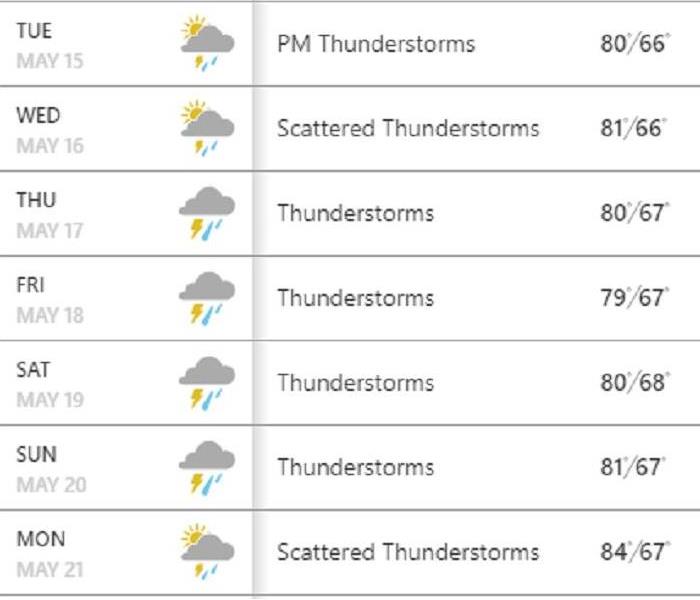 Several days of rain are no match for our highly trained crew. We are ready to respond 24/7 to storm or flood damage in Greenville. (weather.com)
Several days of rain are no match for our highly trained crew. We are ready to respond 24/7 to storm or flood damage in Greenville. (weather.com)
The Upstate is expecting to receive a significant amount of rain over this week, with some days currently showing a 100% chance of rain. Local meteorologists are predicting anywhere from two to four inches of rain during the next five days, as well as prospects of thunderstorms, and some of those storms may be severe. Be sure to be aware of weather alerts and updates to make sure that you, your family, and property remain safe and secure.
Safety is important during severe weather, and quick action afterward is just as paramount in limiting and repairing any possible negative impacts. Consecutive days of rain can lead to flooding or large pools of standing water around/under your home or business, potentially causing water damage or creating ideal situations for microbial growth. Strong winds, heavy rain, and hail can damage structures leading to leaks and other inconveniences that could turn into big problems.
If you need SERVPRO Of East Greenville County ANYTIME, we will be there. Call us at 864-292-3495.
SERVPRO of East Greenville County is ready to help restore your property to pre-storm condition. Our highly trained team is prepared to respond quickly to lessen damage and reduce the restoration cost.
And if the storms cause widespread damage to Greer, we can scale our resources to handle a large storm or flooding disaster. We can access equipment and personnel from a network of 1,650 Franchises across the country and elite Disaster Recovery Teams that are strategically located throughout the United States.
Tornado Safety and Recovery Tips for the Greenville Area
5/13/2018 (Permalink)
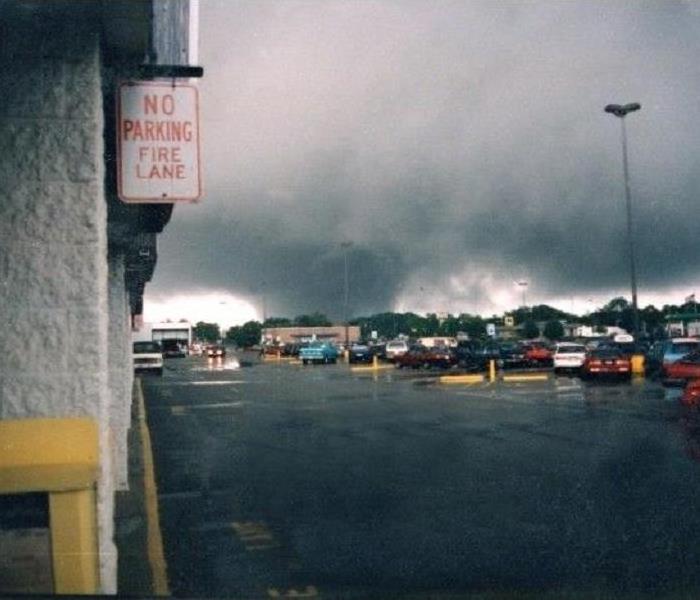 A tornado can form quickly under the right weather conditions. Being Proactive versus being Reactive can help keep you safe.
A tornado can form quickly under the right weather conditions. Being Proactive versus being Reactive can help keep you safe.
If you have ever been through a tornado, then you know how unsettling of an experience it can be. The sky grows dark, the wind roars, you can feel the pressure change. You run under a door frame or to a stairwell, crawl into a bathtub, anywhere to feel safe. And although it only lasts for a few moments, it feels like forever.
Week 2 of National Building Safety Month’s theme is Protecting Communities from Disasters. And in the instance of severe weather like tornadoes and microburst, being prepared is some of the best protection to safeguard our Greenville community. The following are some excellent tips provided by the International Code Council to help become tornado ready.
Getting ready for Tornado Season
We may already be well into tornado season in the Upstate, but it is never a wrong time to start to prepare.
- Make sure your family has a plan to congregate in a safe place during a storm.
- Warn your children about finding a safe place away from home.
- Store flashlights and extra batteries.
- Clean storm gutters and drains.
- Prepare your home for high winds and rain.
- Repair/replace storm shutters.
- Check your property insurance policy for appropriate coverage.
Before the storm
It can be impossible to predict when and where a tornado may form, but taking action when the weather is calling for conditions that can produce tornadoes can save precious time if watches or warnings are issued.
- Bring in outdoor objects such as lawn furniture, toys, and garden tools. Anchor objects that cannot be brought inside.
- Check/replace emergency supplies and store bottled drinking water.
- Review family emergency plans.
- Keep a supply of flashlights and extra batteries handy.
- Secure your home by unplugging appliances and turning off electricity and the main water valve.
During the storm
Severe weather can be intense and may call for quick thinking and action. Knowing what "NOT to do" can be just as helpful as knowing what to do.
- Stay inside in a secure place, away from windows, skylights, and glass doors. Listen to a crank- or battery-operated radio for storm progress reports. DO NOT GO OUTSIDE.
- Stay away from electrical equipment and piping that can conduct electricity from lightning.
- Keep a supply of flashlights and extra batteries handy.
- Avoid flooded roads, and watch for washed-out bridges.
After the storm
The impact of a tornado can leave behind damage and create other dangers. Being cautious and alert can prevent further damage or injury.
- Listen for the all-clear from a community siren, or from local radio. Make sure everyone is okay; get emergency help, as needed.
- Be careful as you assess the damage in your home, watching for live wires, broken glass, nails and other debris
- Take pictures of any damage to the house and its contents for insurance claims.
- Check the exterior. Avoid loose or dangling power lines and report them immediately to the power company, police or fire department. The same goes for gas lines.
- Let your insurance company know of any damage. Work only with accredited companies on any repairs. If you suspect a scam, report it to authorities.
Being prepared goes a long way in keeping a community safe during and after the storm. And if you need us SERVPRO of East Greenville County can help you minimize secondary damage and restore your Greer home, business, or facility to pre-storm condition quickly.
How Innovation Can Help Greer Businesses and Residents Recover from Storms and Floods Faster
5/8/2018 (Permalink)
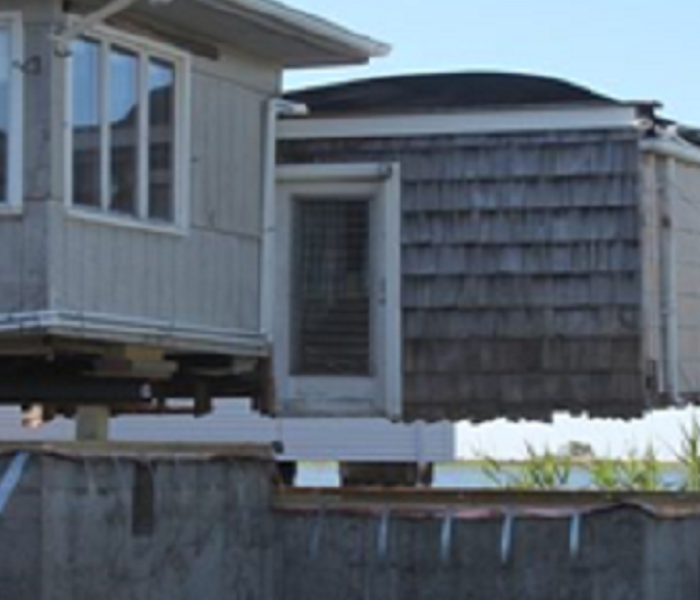 Freeboard is a voluntary increase in the height of new construction or substantial damage requiring elevation adopted by a community. (FEMA)
Freeboard is a voluntary increase in the height of new construction or substantial damage requiring elevation adopted by a community. (FEMA)
The weather in the Upstate can provide us with amazingly beautiful days, and sometimes it can leave us in a bit of a bind. Our area’s location at the base of the foothills is mostly protected from harsh winter weather that comes in from the northwest by the mountains. But a significant portion of our rain events can come from the southwest and are not blocked, and some unfortunate storm events come from the east and are then held in our area by the same mountains that shelter us from the snow and ice. When a storm system is held over our area, high rainfall totals can cause the many creeks, rivers, and lakes in Greer and Greenville to rise and waters to flood. Roads are impassable, bridges swept away, homes and businesses are damaged.
Week 2 of National Building Safety Month’s theme is Advancing Resilient Communities Though Science & Technology. Here is some general information about an innovation designed to help limit the negative impacts of water damage.
What is Freeboard
Weather control technology is (fingers crossed) decades away, but innovations and advancements have been made to limit the damage and reduce recovery time and cost. One such innovation is using a process called “Freeboard” to elevate a structures lowest floor 1 to 3 feet above predicted flood levels for a given area. In most instances, the cost of incorporating Freeboard into building a new structure or renovation of an existing structure can be offset by the reduction of premiums. *It is critical to consult with a licensed insurance professional to discuss if Freeboard will have an impact on premiums.*
Benefits of Freeboard
- Increased protection from floods and storms. Storm waters can and do rise higher than shown on Flood Insurance Rate Maps (FIRMs). Freeboard helps protect buildings from storms larger than those that FIRMs are based on and provides an added margin of safety to address the flood modeling and mapping uncertainties associated with FIRMs.
- Greatly reduced flood insurance premiums. Recognizing that freeboard reduces flood risk, the Federal Emergency Management Agency (FEMA, which administers the NFIP) provides substantial (sometimes more than 50 percent) reductions in flood insurance premiums for structures incorporating freeboard. These savings can rapidly accumulate, especially over the life of a normal mortgage.
- Codes are cost-effective, too. A study for FEMA done by the National Institute of Building Sciences’ Multihazard Mitigation Council showed that for every dollar spent on mitigation efforts like adopting current codes, four dollars were saved in post-disaster relief costs.
Who Can Benefit from Freeboard
- Homeowners- Whether or not you live in the house year-round, having it elevated increases the chances that it will weather storms safely, decreasing your worry and protecting your investment. If you’re building a new home or doing a renovation, ask your builder/designer about incorporating freeboard.
- Builders/contractors- Freeboard provides a competitive edge over other builders, allowing you to market the benefits of reduced flood insurance and flood risk to potential buyers. When doing retrofits (especially those requiring bringing structures up to current NFIP standards), explain the benefits of freeboard to your clients.
- Municipalities- When constructing new municipal buildings (schools, fire stations, etc.) use freeboard as a means of saving tax dollars. Encourage all new construction in your community to include freeboard.
- Businesses- Freeboard helps: protect your buildings, important records, and inventory from flooding; drastically decrease your recovery/clean-up time after the storms, and potentially save your business. The Institute for Business and Home Safety reports that more than 25 percent of businesses that close due to storm damage never reopen.
Information provided by Mass.gov
For more information about Freeboard contact your licensed insurance professional. If your home or business has been impacted by a flood or rain event, SERVPRO of East Greenville County can assist you with water damage repair and restoration or mold remediation and restoration.





 24/7 Emergency Service
24/7 Emergency Service




















